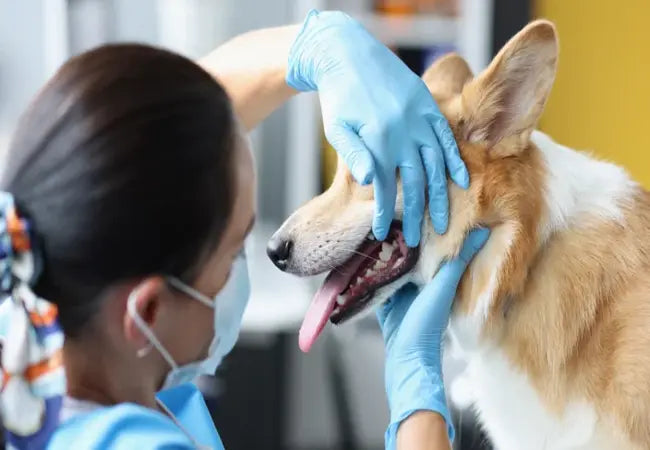Dog Tooth Extraction 2025: Expert Veterinary Guide 🩺🐾

In this article
Dog Tooth Extraction 2025: Expert Veterinary Guide 🩺🐾
By Dr. Duncan Houston BVSc
Hello, I’m Dr Duncan Houston BVSc, veterinarian and founder of Ask A Vet. Dogs often need tooth extractions due to disease or damage. This 2025 guide explains why we may remove a tooth, what happens during the procedure, the costs involved, recovery protocols, risks, and how to prevent extractions in the first place. Let’s ensure your dog enjoys a pain-free, healthy mouth! 🐶🦷
1. 🎯 Why Extractions Are Needed
- Severe periodontal disease: Infection and bone loss around a tooth root, leading to pain and instability. Removing the tooth eliminates the source.
- Tooth fractures: Broken teeth exposing pulp often require extraction to remove the infection and pain source.
- Malocclusion: Misaligned or retained baby teeth can cause crowding, and extraction improves comfort and oral health.
- Abscessed teeth: Root infections might need extraction when a root canal isn’t an option.
- Retained deciduous teeth: Puppy baby teeth that remain can prevent proper eruption of adult teeth.
2. 🛠️ Extraction Procedure Explained
All extractions involve detailed planning and precision. Typical steps include:
- General anesthesia with IV catheter and monitoring.
- Pre‑operative bloodwork and physical exam to ensure anesthetic safety.
- Dental x‑rays to assess root condition and nearby bone involvement.
- Nerve blocks to minimize pain during and after extraction.
- Luxation and elevation—loosening the tooth with dental tools.
- Sectioning of multi-rooted teeth or bone removal with drills to prevent damage.
- Suturing the gum using absorbable stitches and sometimes placing a periodontal flap.
- Finishing with scaling, polishing, and cleaning the surrounding teeth.
3. 💵 Cost Breakdown
-
Per tooth extraction:
- Simple extractions: $10–$200 per tooth.
- Complex extractions (multirooted teeth, carnassials): $300–1,500+ per tooth.
- Full dental surgery: Usually includes cleaning, x‑rays, bloodwork, anesthesia, and multiple extractions—totaling $500–4,000+.
- Insurance support: Accident/illness coverage may cover up to 90% if not pre-existing.
4. ⚠️ Recovery & Home Care
- Initial grogginess for 12–24 hrs; keep calm and quiet for 48 hrs.
- Soft diet for 7–14 days—avoid hard chews and bones.
- Pain management with NSAIDs (e.g., carprofen); antibiotics if infection risks present.
- Monitor for bleeding, swelling, refusal to eat—call vet if prolonged or severe.
- Suture check around 10–14 days; most dissolve on their own.
- Reevaluation: ensure healing and absence of complications.
5. 🩺 Potential Complications
- Infection or abscess: Needs antibiotics and monitoring; tooth sockets prone if bacteria enter.
- Dry socket (alveolar osteitis): Painful healing from clot loss—needs veterinary care.
- Bleeding or hematoma: Easy bruising or hemorrhage—monitor and call vet if bleeding continues.
- Fractured jaw (rare): Risk in small dogs or embedded roots—may require referral and imaging.
- Anesthesia side-effects: Occasionally occur in older or ill pets—bloodwork minimizes risk.
6. 🏥 Preventing Extractions: Best Practices
- Brush daily with canine toothpaste.
- Annual anesthetic dental scale & x‑rays from age 2+.
- Use VOHC-approved dental treats and chew toys.
- Routine checks for loose, fractured, discolored teeth or bad breath.
- Prompt extraction of retained baby teeth to prevent dog malocclusion.
7. 🧩 Support from Ask A Vet, Woopf & Purrz
- Ask A Vet: Telehealth guidance pre- and post-op on pain meds, diet, and home care.
8. 📝 Final Thoughts
Tooth extraction in 2025 is a safe, standard procedure to resolve oral pain and disease. Costs vary from $10 to $1,500 per tooth, with full procedures reaching $4,000+. Although extractions may seem daunting, they significantly improve your dog's quality of life. With effective after-care, monitoring, and prevention, many teeth can be retained. If your dog shows signs like soreness, loose teeth, or bad breath, schedule an evaluation. And lean on tools like Ask A Vet to guide you from diagnosis to recovery. A healthy mouth = a happy pup 🐾💙.


